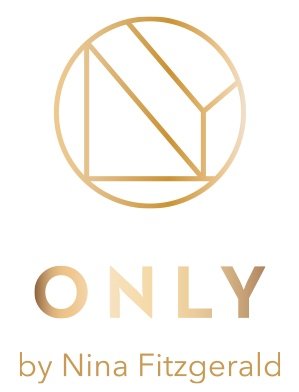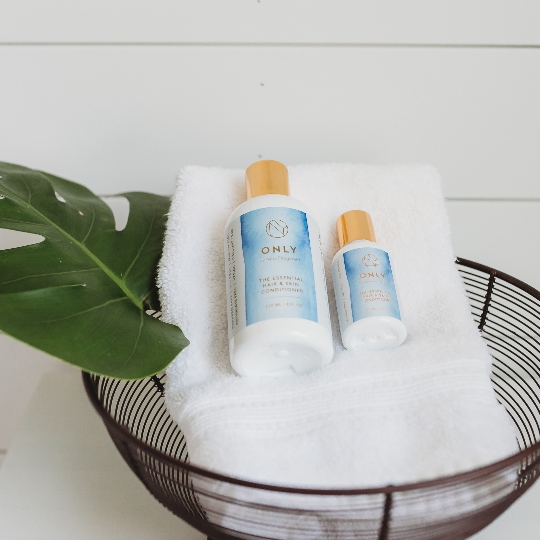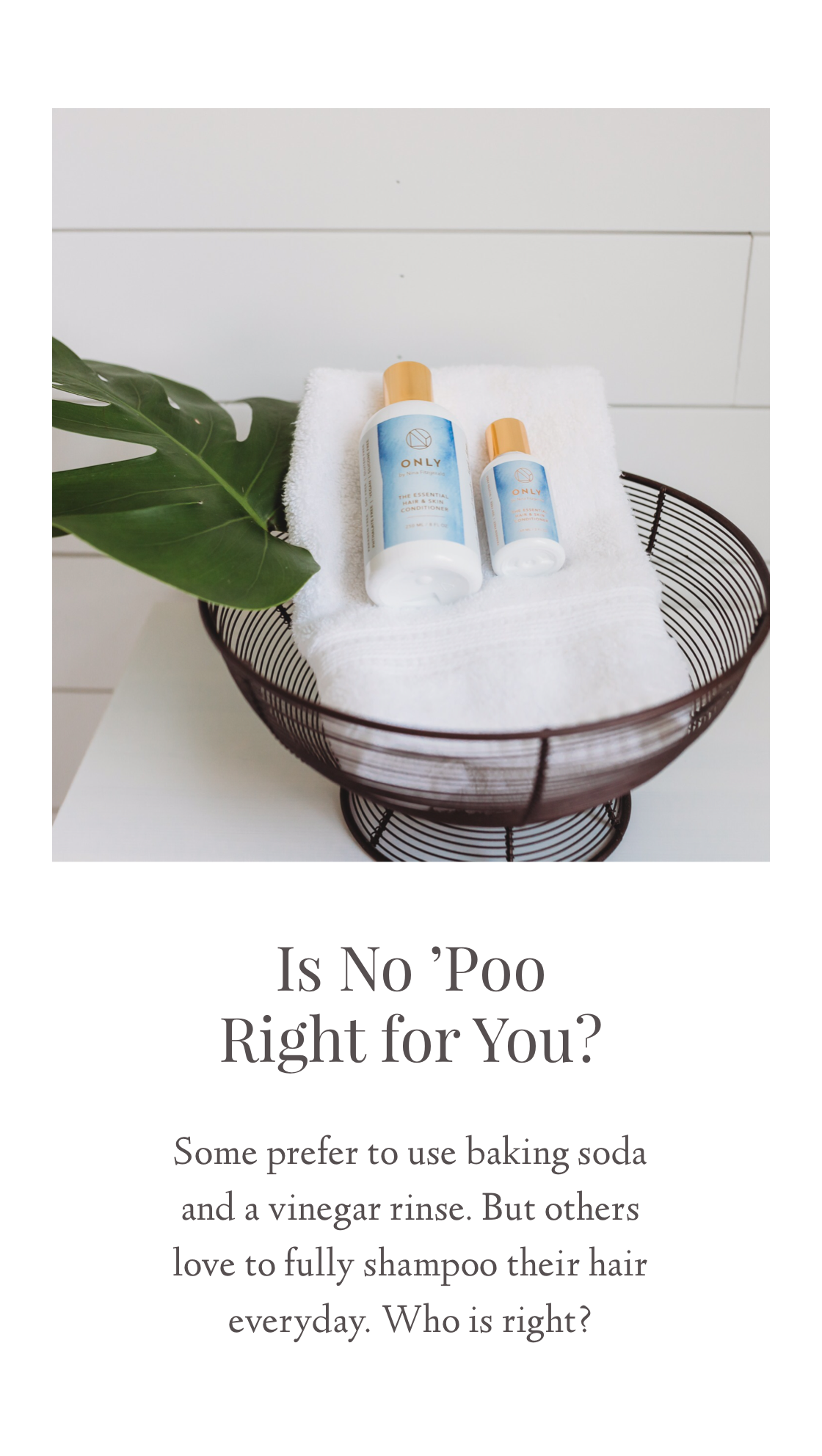Meet ONLY’s Newest Arrivals
Check out all our new offerings today!
ONLY GENTLE SHAMPOO & FACEWASH
What’s the difference between the skin on your face and the skin on your scalp? Your face is about 6 inches lower. So why not have a shampoo and face wash all in one?
ONLY Gentle is designed to cleanse the scalp and face without harsh surfactants stripping the skin of oil. While safe for daily use, this little bottle packs a punch and can even be used as a bubble bath for the little ones. (And the big ones, too. Everyone deserves a bubble bath!)
ONLY FLAT PADDLE BRUSH
What’s this? Nothing but the best little paddle brush around to smooth out hair and detangle your tresses. This lightweight wooden brush fits nicely in the hand, and it is perfectly adorned in ONLY fashion.
ONLY TAME
What a beautiful time for new hair! What I’m most excited about in this scent-free product is the addition of the Aloe Vera Leaf juice for extra hydration.
That means it softens the outside of the hair very well, and it helps to break down dead skin cells.
Imagine getting a fresh yellow onion: You need to peel off the outer edges to get to the softer parts. Aloe does that for your hair, and is phenomenal for beard hair, too!
(And unlike typical beard lotions, Tame doesn’t contain any oils!) Check out all our new offerings today!
XOXO,
Nina
ONLY for the Littlest Ones
Does your little one have cradle cap? Don’t worry! ONLY Conditioner is gentle enough to use on your kiddo’s hair and skin every day.
Is there anything softer than a baby’s cheek? Maybe their little squishy toes. Or the downy tufts of hair on their heads.
But here’s the truth: Babies get dandruff, too. It’s called cradle cap, and while It’s common and painless, it doesn’t look or feel great. It’s caused by your baby’s oil glands working overtime, giving their skin a scaly look and feel.
Does your little one have cradle cap? Don’t worry! ONLY Conditioner is gentle enough to use on your kiddo’s hair and skin every day.
Treating Cradle Cap
On their dry scalp, put about a half dollar-size amount of ONLY.
Scrub ONLY into the scalp with a soft bristle brush.
Wet hair just a little and re-scrub to create a lather.
Rinse and repeat again, if necessary.
If a portion of the cradle cap doesn’t want to budge, do not force it off. Re-try again the next day on dry hair and it will naturally loosen from the scalp.
XOXO,
Nina
The Art and Act of Going Green
Most companies will say that they are going green, but what does that really mean? Nowadays, companies try to push products under the guise that they are clean, chemical-free and made with environmentally conflict-free methods.
Ahhhh, the art of going green! It seems like an easy task, but when it actually comes down to it, it’s pretty tricky.
Most companies will say that they are going green, but what does that really mean? Nowadays the market is getting into a cycle of “greenwashing,” where companies try to push products under the guise that they are clean, chemical-free and made with environmentally conflict-free methods.
Unfortunately, saying and really doing are two totally different tasks; the standards vary from company to company, and from country to country.
Online Shopping
Were you aware that Carnegie Mellon's Green Design Institute found that choosing to shop for 100 percent of purchases online would lead to a 35 percent reduction in emissions?” One way to decrease waste is to simply offer more online shopping!
By reducing the amount of cars out on the street that go to purchase individual items and shipping through fleets, there is actually a reduction in the amount of CO2 (carbon emissions) dollar-for-dollar of goods sold.
Look at Germany: They actually have one of the most efficient systems of reducing the amount of waste byproduct. How do they do this and how do they ensure that everyone plays along? They put the onus on the manufacturer to make sure that all of the product containers and waste from their products is recycled. In doing so, Germany has seen a drastic reduction in the amount of waste that is produced, and have increased the amount of recyclables that are picked up.
If you do care to learn a little bit more, here are the stats and the write up from 2018.
Plastics Get Complicated
Now onto the talk about plastic bottles.
I wish this was a lot easier of a task, but it’s really hard. There is a huge movement to make plastics more biodegradable and from natural sources, like corn. In theory it sounds great, but many of these options still give off noxious gases and cannot be used in organic farming. Traces of the material that the container is made from won’t fully break down, and they are impossible to separate from the soil.
And here comes the real kicker: It might have better ability to biodegrade on land. “In the oceans, the water is usually too cold to break down biodegradable plastics, so they either float forever on the surface (just like conventional plastics) or, if they do break down, produce tiny plastic fragments that are harmful to marine life.”
AKA, welcome to the wonderful world of micro plastics. So, if the container doesn’t have a zero marine toxicity seal of approval -- meaning it will not harm or add to the pollution in the ocean --it’s still a big nope.
That takes us back to tried and true, which is still slightly better than throwing something away, which means looking for the easiest plastics to recycle: #1 PET and #2 HDPE plastics.
Truthfully, there are many companies decreasing the amount of overall plastic that they use, and some that I was actually surprised to learn about:
Coca-Cola wants to recycle one bottle or can for every bottle or can that they sell by 2030.
McDonald’s will have 100 percent recycling in all of their locations by 2025.
Aramark has a huge campaign to reduce single-use plastics by 2022.
Even if they decrease their waste by a small amount, these companies are so widespread and emit so much, that they will have a global impact with even a fraction of the reduction in plastic waste. If we can’t get a government-mandated reduction, or bills passed to force companies to be more sustainable, at least some of the biggest players in our economy are trying to turn the tides.
Change doesn’t happen overnight, but if corporations work together, people will feel the impact.
What about ONLY?
What is ONLY doing in this great race to help decrease waste?
For starters, we are trying out more eco-friendly packing materials. For instance, the filler that surrounds the bottles will be now padded with the most biodegradable form of recycled paper. Take it out of the box, and it can immediately be used in the garden to help keep moisture in the soil. And you don’t have to worry about any additives that have been sprayed on the paper, or waxy residues that don’t break down.
We are also exploring reusable containers that can be refilled at retail locations, or through a mailer that will be included with purchases to send the old bottle back for refilling. In the meantime, we will ONLY use plastics that are the most accepted at recycling plants until we can find -- or someone makes -- something durable enough to hold product and not decompose while sitting in the shower.
We will also look into going fully fragrance-free. I know this will upset some people because I also love the smell, but it brings up many issues of what all it takes to make smells, aromas and compounds that make up fragrances in our product. Some of the essential oil isolates used in ONLY are on the endangered plant list (one example being Sandalwood).
Studies even go as far as saying that essential oils should never come into contact with any open water or groundwater because contamination will have long-lasting effects and they are extremely toxic to marine life. BUT don’t worry: I will have many discussions about the essential oil isolate in upcoming blogs to hear all of your comments.
How would you like to see ONLY become more environmentally friendly? Sound off!
XOXO,
Nina
To shampoo or not to shampoo?
Do we really need to shampoo? Believers in the no-poo movement, who prefer to use baking soda and a vinegar rinse, don’t believe so. But, some people also love to fully shampoo their hair everyday. Who is right?
Shampooing has been around for ages: 300 years to be exact. It was originally called “champu” and came from an Indian tradition of massaging the head with fragrant oils. But the modern-day foamy luxurious washes that you know now were only developed around the 1930s, gaining full momentum and popularity by the 1970s and 80s.
But do we really need to shampoo? Believers in the no ’poo movement, who prefer to use baking soda and a vinegar rinse, don’t believe so. But, some people also love to fully shampoo their hair everyday. Who is right?
Well it all comes down to:
cleanliness and how well you scrub,
suds or no suds,
and how well you make sure the hair is balanced back down.
Let’s break this down further. Growing right next to each and every strand of hair is a little gland that produces oil, or sebum, to help the follicle maintain its strength and keep its elasticity.
Aside from natural hair sebum, oil does not have the ability to collapse the cuticle to make it lay flat. All it can do is coat the hair and lead to buildup or breakage if used too often or before the hair is properly hydrated. Yes, it will make it shiny, but add too much and your hair can feel weighed down, flaky and frizzy. This goes for ANY hair type.
That’s why using an oil-free conditioner will balance the scalp and create the perfect environment for hair growth and clear skin.
When properly balanced, it produces enough to cover each individual strand and the scalp remains clear and without excess oil. But, if the scalp is not cleansed properly, over time the excess oil produced on the scalp can lead to dandruff and hair fall. (WHAT!?)
Don’t worry, keep reading.
How pH Levels Affect Your Hair
Think of pH as a level system that exists from 1-14. Right in the middle is neutral water at a 7. Your hair and scalp want to live around the 4.5-5.5 level. Now, the more that your hair stays in the level of 4.5-5.5, the better it will grow, the healthier it will be, and the less oily it will be. Are you following me so far?
Anything that is from 6 all the way to 14 will start to open the cuticle of the hair (think of a pinecone opening) which can lead to water loss. Levels 9 to 14 can actually start to cause damage to the cuticle and really dry out the hair if not properly balanced back.
The suds that are in shampoos, or the surfactants, help to rid the scalp of all of the excess oil, dead skin cells, dirt and grime that has accumulated since the last time that it was rinsed. For the most part, shampoos exist from about 6-8.5. Shampoos lower on the scale are softer, and only open the cuticle a little. Shampoos that are higher on the scale are stronger, opening the cuticle more.
The Low Down on No ’Poo
In the no ’poo world, baking soda does the same job as shampoo. (Baking soda is medium on the pH scale at a 9, the same as a purifying shampoo. They open the cuticle up so it can get rid of the oil and debris.)
The no ’poo method works by using baking soda as a “shampoo” to cleanse and then apple cider vinegar to rinse and neutralize. It can feel like it works, but remember: Baking soda is a very harsh surfactant at a pH of 9. Harsh surfactants can be harmful to your hair and actually lead to more hair distress over time, with more breakage or build up.
Strong cleansing shampoos can also lead to more damage because they can strip all of the natural oils off of the scalp, leading to consistent dryness and flakiness if not properly balanced. And that means potential hair loss!
What works best are very mild shampoos to cleanse normal, everyday dirt and excess oil off of your scalp without fully stripping all of the natural oils that balance your hair.
Do you want to know how you can use ONLY Conditioner like a shampoo? I’ll guide you through co-washing, step-by-step.










